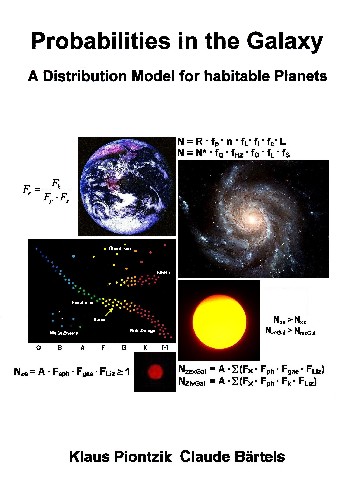Cases 2 and 3 of
the case distinction can be used to obtain a
minimum-maximum statement.
Inserting all values (Fe = 0.1) into equation
3.1.1:
Nhe1 = (100-300)·109
· 1:15,000 · 1,212:3,286 · 51:130 · 1:10
Nhe1 = 96,465 –
289,395 habitable „Earth 2“
Inserting all values (Fe = 0.01) into equation
3.1.1:
Nhe2 = (100-300)·109
· 1:15,000 · 1,212:3,286 · 51:130 · 1:100
Nhe2 = 9,646 –
28,939 habitable „Earth 2“
The two results can then be summarized to the following
statement:
| 3.3.1 Theorem |
There are probably 9,600 to
289,000 "Earths 2", in solar-like star
systems, in our galaxy. |
The probability for a habitable, earth-like planet, in
solar-like star systems, in the galaxy, is then:
| 3.3.2 Definition |
Fhe
= Fsph ·
Fg
· Fa ·
Fe
Fhe=
Fs
· Fp
· Fh ·
Fg ·
Fa ·
Fe |
Fhe = Fs·Fp·Fh·Fg·Fa·Fe
= 1:15,000 · 1,212:3,286 · 51:130 · (1:10-1:100)
= 1:1,036,643 – 1:10,366,433
Only every 1.036 - 10.366 millionth star
system has a truly earth-like planet.
If you only look at the habitable planets about the size
of the earth, then you can establish a probability for
the similarity to an "Earth 2".
| 3.3.3 Definition |
Fgae
= Fg
· Fa ·
Fe |
Two values can be generated:
Fgae1 = 1,212:3,286 · 51:130 ·
1:10 · 1:69
Fgae2 = 1,212:3,286 · 51:130 ·
1:100 · 1:691
According to definition 1.7.1:
Fsph = Fs·Fp·Fh
Then equation 3.1.1 for an "earth 2" can also
be expressed as follows:
| 3.3.4 Equation |
Nhe
= A · Fsph
· Fgae
Nhe
= A · Fs ·
Fp ·
Fh ·
Fg ·
Fa
· Fe |
|
Fsph =
1:15.000 Faktor für eine habitable zone
Fgae = 1:69
bis 1:691 Faktor für Earth similarity
|
